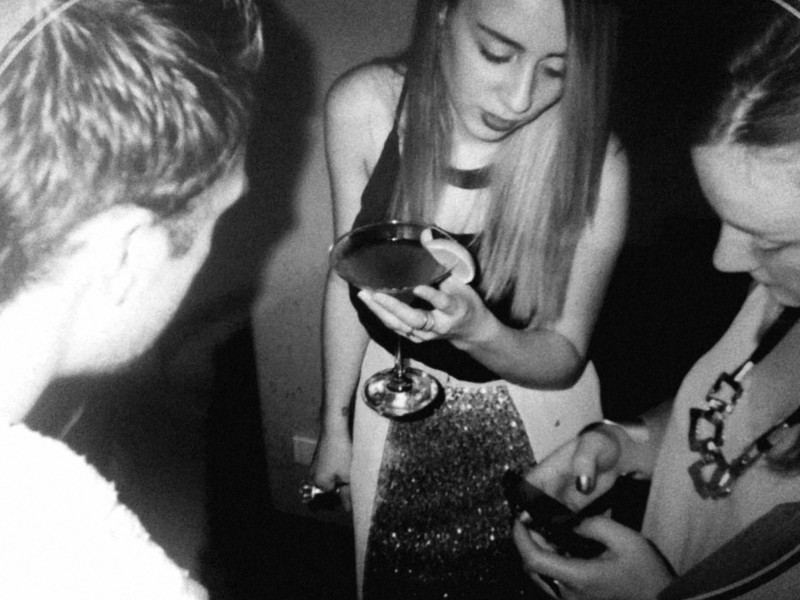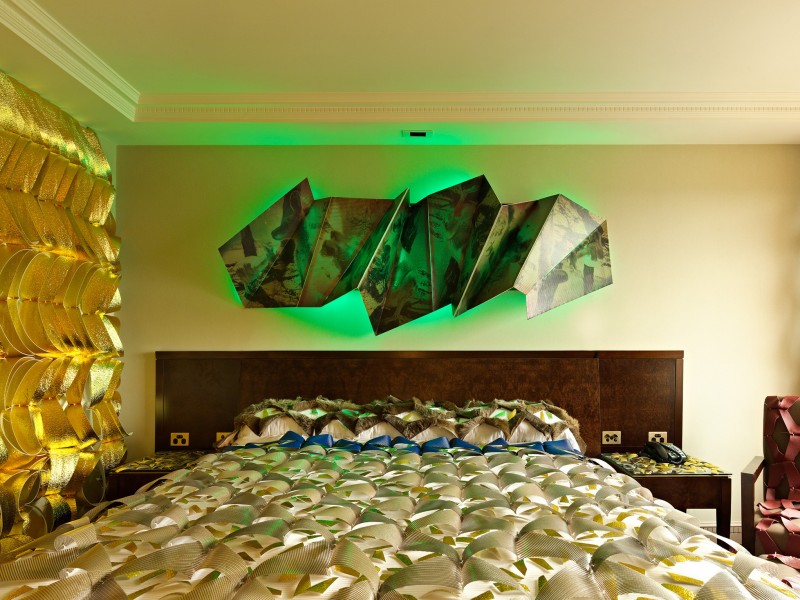The past never looked so exotic. Broached Commissions creates bespoke objects by marrying authenticity and spectacle.
The sheiks are coming. The gossip whips through Dubai’s design fair like a desert sandstorm. Each one of the thirty international design galleries knows its fortunes could change instantly. Entire stock could be bought in one beneficent gesture. Better still, patronage and commissions could flow like gulf oil.
Amid the contemporary furniture design collections, the star of the Design Days Dubai show is Lucy McRae’s exotic Prickly Lamp. Resembling an unholy union of alien tripod and Australian echidna the lamp is constructed from a quarter-of-a-million colour-graded toothpicks. Nearby stands Trent Jansen’s equally strange Briggs Family Tea Service made from wallaby pelt, bull kelp and slip-cast porcelain. Steeped in Australia’s colonial history these works represent Broached Commissions. One of Australian design’s most ambitious ventures, Broached Commissions is unusual in curating and commissioning its own designs. Using a core group of designers—Trent Jansen, Adam Goodrum and Charles Wilson—Lou Weis’s Melbourne-based venture is an exercise in design history. It explores how ideas arrived and evolved in Australia. “It’s about deepening the narrative of place,” he says.
Each Broached Commission series examines a specific historical period. Where Broached Colonial explores the collision of European settlement with aboriginal society and Australia’s flora and fauna, Broached East investigates the influence of Asian migration on Australia in the wake of the 1850s gold rush. “History is the glue for us,” says Weis, creative director of Broached Commissions. “I don’t think you can be new and interesting unless you understand what the old is.”
Weis likens his venture to haute couture. “A mixture of art and design installation, it’s the bleeding edge of the design market,” he says. As such these highly experimental pieces (with just two to eight made of each), come with a premium price tag, ranging from $8,000 to $45,000. Weis’s invitation to Dubai is not just to spruik his limited-edition commissions, but host a panel on ‘authenticity in design’. In the wake of Dubai’s massive development over the past decade the cultural desert has been transformed into an oasis of art and design. It’s the latest economic powerhouse that hopes to define itself not just through primary-industry commodities but sophisticated culture. “It’s frontier land stuff,” says Weis, who sees parallels across the centuries. Today it’s oil. In 19th century Australia it was gold.
Just as Dubai has thrust itself in the global marketplace as a travel hub between east and west, during the 19th century Australia’s gold rush brought about the greatest migration seen up until that point. It saw Chinese prospectors directly engage with locals, the emergence of mass media and the spread of the Japanese aesthetic. Then as now a fear existed that internationalisation would ruin the local artisan base.
“The dilemma starts during the high point of the industrial revolution in the mid-19th century,” says Weis. “[In England] you’ve got the 19th century Arts and Crafts movement saying ‘if we lose all of our making capabilities then what makes us distinct disappears, and basically you’re just in a sea of ubiquitous industrialised product’.”
English designer William Morris most vocally perceived industrialisation as a threat to integrity and honour. Indeed Dubai and the Emirates face the prospect of a similar fate, according to Weis. “I would suggest they ought to develop the narrative of what gets made there, look more deeply into the Pan Arabic aesthetic and draw on the most beautiful elements of it,” he says. Perhaps unwisely Weis attempted to draw the sheiks into an enthusiastic discussion on comparative design histories. “I pitched it wrongly,” he concedes with a chuckle. “They do not have time for a conversation, but can only stop for literally a minute or two and then move on.” The sheiks, he says, “respond less to the historical spiel and more to the forms and the textures of the materials”. McRae’s Prickly Lamp sells to an advertising creative instead.
Indeed it’s creatives and entrepreneurs who react most positively to the Broached series. In part Weis attributes this to his collections’ emphasis on narratives. “Entrepreneurs have built their lives around a story that they believed in, or they’re involved in venture capital and they help build that narrative with that person from the ground up,” he explains.
Designer Trent Jansen has produced work for both Broached Commissions. His Briggs Family Tea Service took its inspiration from the marriage between a European whaler and a Tasmanian aboriginal woman. Jansen’s Chinaman’s File Rocking Chair responds to the stories of the roughly 16,500 Chinese prospectors who arrived in Australia and walked 480 km to the goldfields. Both were created using traditional craftspeople and artisanal techniques in Australia and China.
Conceptual thinking and authentic artisanal practices are essential to Broached Commissions says Weis. “If we work internationally we have to work with local curators and local makers and at least one local designer to be authentic,” he says. Hence the series involves designers from the culture that influenced the Commission. Broached Colonial commissioned English designer Max Lamb, while Broached East commissioned Chinese designer Naihan Li and Japanese designers Azuma Makoto and Keiji Ashizawa.
“Design is a set of incremental improvements to the functionality and beauty of the things we use in our daily lives,” says Weis. “I want to go back and look at how those ideas arrived here.” If the rise of international design fairs, specialist galleries and million dollar auction prices for the likes of Marc Newson’s Lockheed Lounge suggest a renewed appreciation for design, Weis believes a passion for limited-edition design exists among every generation.
The appeal of the limited edition lies in being the prototype of great thinking, says Weis: “It’s about being close to the origins of the brilliant thinking that resulted in something that then became ubiquitous. The idea of the limited-edition design goes back to where artisanal practices begin.”
“A certain part of the population understands that is what contemporary luxury is. That the time has been taken to investigate, because time is a big part of contemporary luxury. It’s not just the product, it’s the investment of time and research.”
Indeed Weis’s research extends beyond product design. It involves an appreciation for the marketplace. Now more than ever people crave authentic experiences, he believes. “For those who travel and live an elevated first-class lifestyle when they land [in a city] they want to touch something that feels real. If that’s been ripped out of the city then they don’t want to keep going back. That’s the problem with the industrialised manufacturing cities of China.”
Further proof of the quest for authentic experiences can be found in the retail sector. “People are spending their disposable income on experiences—yoga, restaurants, bars, travel,” he says. “They’re not necessarily buying a lot of products. A certain class of the population is after a luxury of experience rather than a luxury product.
“You can see in contemporary art the privileging of experience over traditional plastic objects,” he adds. “I think there’s a reason why artists like Olafur Eliasson and James Turrell are two of the biggest artists in the world currently, because they offer a sensory experience that makes us aware of the limits of our optical or aural capabilities.”
Such experiences also provide an antidote to the overwhelming time spent mediated through computers. That desire to have our bodies made active again and understand our relationship to space and to the environment through playing with your senses also explains why signature architecture such as the work of Herzog & de Meuron has become so popular now, Weis believes.
Related Features
-
29
-
-
-

